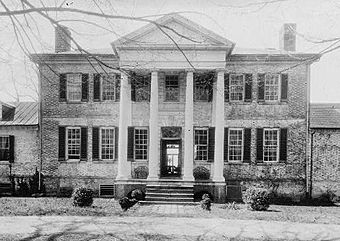Sabine Hall (Warsaw, Virginia) facts for kids
|
Sabine Hall
|
|

Sabine Hall, HABS Photo
|
|
| Location | Sabine Hall Rd., near Warsaw, Virginia |
|---|---|
| Built | 1735 |
| Architectural style | Georgian |
| NRHP reference No. | 69000277 |
Quick facts for kids Significant dates |
|
| Added to NRHP | November 12, 1969 |
| Designated NHL | April 15, 1970 |
Sabine Hall is a very old and important house located near Warsaw, Virginia in Richmond County, Virginia. It was built around 1730. This amazing brick house is a great example of Georgian style. A famous person named Landon Carter (1710–1778) had it built. Sabine Hall is so special that it was added to the National Register of Historic Places in 1969. It was also named a National Historic Landmark in 1970.
Contents
Discovering Sabine Hall
Sabine Hall sits in a quiet countryside area south of Warsaw, Virginia. It is built on a high piece of land. From here, you can see the Rappahannock River flowing to the south. The land around the house stretches out quite a bit.
What Does Sabine Hall Look Like?
The main part of Sabine Hall is a two-story house made of brick and stone. It is built in the Georgian style. On each side of the main house, there are smaller, one-and-a-half-story brick sections.
The front of the house has a grand entrance. It features a two-story porch with four columns. This porch has a triangular top, which is called a pediment.
Inside Sabine Hall
When you step inside, you find a large central hallway. It measures about 18 feet wide and 48 feet long. This hall is completely covered with wooden panels.
One of the most amazing parts of the house is its stairway. It is made of carved walnut wood. Many people say it is one of the best stairways in the entire country!
Gardens and Views
Outside the house, there are six terraced gardens. These gardens step down the hill towards the river. Imagine walking through these beautiful gardens with a view of the water!
Who Built Sabine Hall?
The main part of Sabine Hall was built around 1730. It was built by a well-known person named Landon Carter (1710–1778). He was a "planter," which means he owned a large farm and managed its operations.
What's really cool is that even when Sabine Hall became a historic landmark, it was still owned by the same family! It belonged to the descendants of Landon Carter.
How the House Grew
In 1764, the house became bigger. A covered walkway was added to connect the main house to the kitchen building. That old kitchen building is not there anymore.
One of the side sections of the house was added a long time ago, but we don't know the exact date. The other side section was built in 1929. This was done to make the house look perfectly balanced on both sides.



